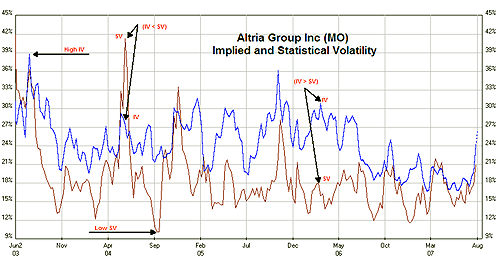In previous chapters, we’ve examined the two forms of volatility: statistical (historical) volatility and implied volatility (IV). We learned that past levels of IV can be useful in determining how expensive options premiums are. In this chapter, we’ll look at the relationship of IV to historical volatility to learn about how to evaluate whether an option is “overvalued” or “undervalued.”
To review, an option trades at prices which may or may not be the same as theoretical values. Put differently, an option’s price may not actually be in line with valuations from the perspective of option pricing models like Black Scholes. This is often known as mispricing. What should we make of this? There are whole careers to be had in academia trying to recast options pricing in an effort to find a more accurate model. Typically, this involves using different measures of historical volatility, although the issue is a huge one that goes far beyond the scope of this tutorial. (For related reading, see Understanding Option Pricing.)
IV Relative to Historical Volatility
When IV and statistical volatility are derived via normalized methods relative to price, the two figures can be compared in terms of both current and past levels. Figure 1 below shows that the two levels of volatility can oscillate around each other some of the time, and that they can remain at different levels over extended periods of time before crossing paths once again. This chart presents a 20-day exponential moving average of current volatility levels, which tends to smooth (or dampen) daily noise.
The chart looks at the real-life example of historical and implied volatility for Altria Group, Inc. between June of 2003 and August of 2007. Historical volatility indicates the actual volatility of the underlying stock, while the IV plot shows the volatility which is implied by the market price of the options trading on that stock. The two volatilities can at times remain very similar, although they are typically not exactly the same. When they are close to the same (or even the same), this indicates that the actual options prices are implying a volatility level which is close to the same as the volatility of the underlying.
At times, though, the two volatilities deviate from one another significantly. It is these times which present a good basis for finding options which are significantly over- or undervalued. Furthermore, by looking at the average levels for the two types of volatility, it’s possible to evaluate when either of the two types of volatility has moved away from average or normal levels significantly. There are some traders who believe that it is easier to predict the direction of volatility than the price of the underlying stock itself. Thus, if the options strategy is the right one, it could be possible to trade a return of volatility to normal levels. Of course, there are also seasonal factors at work which can be isolated for possible volatility trading.
IV and Historical Volatility Spikes
Looking at Figure 1 below, we see that in 2003, a spike in IV levels reached as high as 39%, representing very high IV. Put differently, option prices were very expensive. In September 2004, though, historical volatility goes below 10% suggesting that the stock volatility has sharply declined. Throughout the chart at various times, the reverse of high IV and low historical volatility can also be seen, indicating that the option price valuation conditions are the opposite.
When IV is greater than historical volatility, traders believe that options are overvalued. Conversely, when IV is less than historical volatility, options are believed to be undervalued. In Figure 1, both conditions are indicated at various times.
 |
| Generated by OptionsVue 5 Options Analysis Software |
| Figure 1: Altria Group Inc. implied and historical volatility charts. Historical volatility (historical (statistical) volatility is marked by a brown line; implied volatility is shown in blue. |
IV is a measure of projected volatility, which is dependent upon how expensive options are in the marketplace. Historical volatility, on the other hand, measures how the volatility of the underlying stock or futures contract has been in the recent past. Historical volatility is an input in pricing models, meaning that it indirectly affects theoretical price levels.
Options Mispricing
If actual options prices are greater than historical volatility modeled theoretical prices, IV will stand in for the mispricing. Mispricing can be either above or below theoretical prices; overvalued options are above theoretical, while undervalued options are below. When market prices are higher than theoretical prices, IV is greater than historical volatility. Alternately, when market prices are below theoretical prices, IV is less than historical volatility.
Going back to Figure 1, then, when IV is less than historical volatility (options prices are undervalued, as indicated with arrows in the early 2004 period, when historical volatility spiked), we see a situation that is conducive to a buying strategy. Traders can pick up options at a theoretical discount in these periods. On the other hand, at times when IV is greater than historical volatility (meaning options prices are overvalued, as indicated with arrows in the early 2006 period), a selling strategy may be the best option. This is simplifying the procedure, though; this rule should be combined with an analysis of how expensive or cheap options are at the same time.
Figure 2 shows a summary of ideal conditions for both buying and selling options. As we saw in the previous figure, the “high” or “low” levels are measures of volatility as compared with past levels, and they can be evaluated using a look-bac period of a number of years. In fact, the greater the span of the look-back period, the better.
| - | High Implied Volatility | Low Implied Volatility | High Historical Volatility | Low Historical Volatility |
| Implied > Historical | Selling Bias | Mixed | Selling Bias | Mixed |
| Implied < Historical | Mixed | Buying Bias | Mixed | Buying Bias |
| Figure 2: Volatility conditions for selling and buying options |
When either type of volatility is high and IV>historical volatility, this is often an ideal time for selling options. In this case, both theoretical prices will be high as a result of high historical volatility. Besides, the actual high-priced options prices will be projecting even higher volatility, meaning that there is additional overvalued premium added as well. When the reverse conditions exist (when IV or historical volatility are low and IV<historical volatility), buying is often the best path. Options in these cases are cheap and undervalued. In the other relationships shown in Figure 2, there are mixed volatility conditions, meaning it may not be ideal for either selling or buying.
The Bottom Line
In this chapter, we examined the concept of under- and overvalued options and we looked at how volatility plays into buying and selling considerations. High and low IV and historical volatility conditions were shown to indicate expensive and cheap options, respectively. We also examined the ideal conditions for selling and buying. High IV combined with IV>historical volatility is the best condition for selling, while low IV and IV<historical volatility is the best condition for buying.
Option Volatility: Strategies and Volatility
-
 Trading
TradingImplied vs. Historical Volatility: The Main Differences
Discover the differences between historical and implied volatility, and how the two metrics can determine whether options sellers or buyers have the advantage. -
 Trading
TradingStrategies for Trading Volatility With Options (NFLX)
These five strategies are used by traders to capitalize on stocks or securities that exhibit high volatility. -
 Trading
TradingOption Price-Volatility Relationship: Avoiding Negative Surprises
Learn about the price-volatility dynamic and its dual effect on option positions. -
 Trading
TradingOptions: Implied Volatility and Calendar Spread
Even if risk curves on a calendar spread look enticing, a trader needs to assess implied volatility. -
 Investing
Investing3 Reasons to Ignore Market Volatility (VIX)
If you can keep your head while those about you are losing theirs, you can make a nice return in roiling markets. -
 Trading
TradingAn Option Strategy for Trading Market Bottoms
A reverse calendar spread offers a low-risk trading setup with profit potential in both directions.



